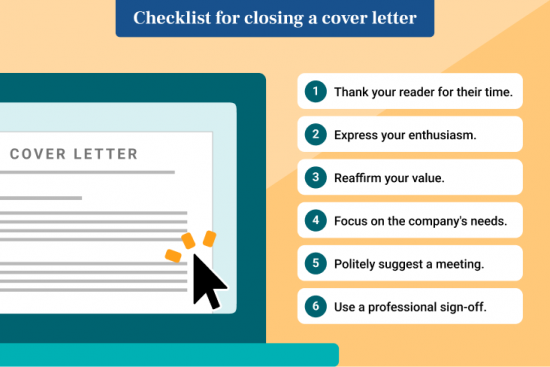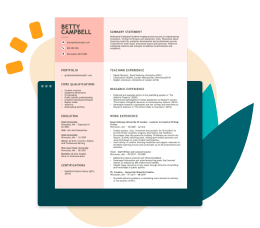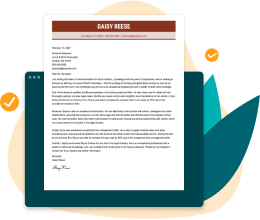How to Write a Letter of Application with Examples
Write a compelling letter of application with our step-by-step guide and job-specific examples that improve your chances of being considered for your desired job.
Are you embarking on the journey of job hunting? A letter of application can help you go the distance in your job search!
Often synonymous with a cover letter, this invaluable document is your introduction to potential employers. It’s not just a piece of paper; it’s your narrative, your first handshake in the professional realm.
In this article, we’ll provide clear steps, expert tips and job-specific cover letter examples to help you write a compelling cover letter — your key to unlocking fantastic professional opportunities. Ready to make your words work wonders? Let’s dive in!
Letter of application example
First, this is how a letter of application should look like. You can use this example of an application letter as a starting point for your own.
There are so many job applications, yet so little time. We understand that writing new application letters for each role can be time-consuming, so we created our Cover Letter Generator! By typing your job title and answering simple questions, our builder can generate a personalized application letter in minutes.
How to write a letter of application
You can write a compelling letter of application that has recruiters calling you for an interview by following a few easy steps and some not-so-secret tips and tricks.
Before you dive into writing, let’s start with a crucial step:
STEP 1
Research the company you’re applying to.
It sounds redundant, but a big part of your letter of application is showing recruiters you’re genuinely excited about the role.
Doing some homework to browse the company website or LinkedIn will help you identify a pattern of values that create the company’s “corporate culture.”
Many companies will also publicly share awards they’ve won or projects they’re embarking on. With this information, you can write an application letter showing recruiters you know what the company is working toward.
You can even demonstrate you’re ready to hit the ground running if you get the job by sharing ideas or potential solutions that align with the company’s goals.
STEP 2
Structure your header correctly.
Now that you have some background on what the company is looking for in a candidate, you can begin writing your letter of application.
The first section of your application is the header or letterhead. Formatting your letterhead in a business-letter style is crucial for professionalism. Ensure your header includes your contact information and the date, aligning with conventional business letter formats.
Application letterhead template
[Your Name]
[City, State, ZIP Code]
[Your Email Address]
[Your Phone Number]
[Today’s Date]
[Recipient’s Name, Job Title]
[Company Name]
[Company’s Address]
[City, State and ZIP Code]
Good example:
Alyssa Guadigino
Newark, New Jersey 07106
example@example.com
555-555-5555
February 18, 2024
Carla Rivera, HR Manager
Turin & Co., LLC
77 E 4th St
New York, NY 10014
Bad Example:
Alyssa Guadigino
example@example.com
555-555-5555
STEP 3
Greet the hiring manager.
When addressing your letter, strive to find the hiring manager’s name since this personalizes your letter and shows your attention to detail.
However, if the hiring manager’s name is unavailable, what can you do to address a cover letter without a name?
The best option is to use a generic but appropriate greeting, such as “Dear Hiring Manager” or “To the Growth Marketing Department.”
Good example:
Dear Ms. Johnson,
Bad example:
To whom it may concern,
STEP 4
Grab recruiters’ attention in the opening paragraph.
The opening paragraph is your chance to show recruiters those essential qualifications that make you a desirable candidate.
Highlight essential soft skills, mention required qualifications or even add a bit of personal branding to make a memorable first impression.
Good example:
As an enthusiastic and adaptable marketing coordinator with six years of experience and a passion for fostering collaborative environments, I bring a unique blend of creativity and strategic thinking to your team at XYZ Corporation.
Bad example:
I am writing to express my interest in the position at your company. I am a hard worker and a fast learner.
A weak opening paragraph is vague and sparse. In contrast, a solid opening paragraph should demonstrate your communication skills by aptly conveying to recruiters skills and qualifications the employer seeks in a candidate.
Looking for more examples and tips for nailing this part of your application letter? Check out our in-depth guide on How to Write the First Paragraph of Your Cover Letter.
STEP 5
Share your best qualifications in the body paragraph.
In the body of your letter, you have a golden opportunity to present a compelling case for why you are the ideal candidate for the position.
The body paragraph is the most flexible section of your letter of application because you can employ different approaches.
If you’re an applicant with a lot of relevant experience, you can focus on sharing more relevant quantifiable achievements that showcase your expertise.
Suppose you’re a job seeker with little to no experience. In that case, you should use the letter of application to target potential concerns an employer may have, such as being a recent graduate, having an employment gap or changing careers. You must face these limitations head-on and quickly pivot to the qualifications you can offer the employer, especially transferable skills from previous experiences that you can employ in the role.
Check out these body paragraph examples to identify what works and what doesn’t:
Good example:
With four years in accounting, I excel in financial analysis, reporting and strategic decision-making. In my current role, I streamlined expense tracking, reducing reconciliation times by 30%, which enhaced accuracy and enabled timely decision-making. Proficient in QuickBooks and Excel, I bring efficiency, precision and a proven track record of process improvement to elevate Enco Accounting’s financial operations.
Bad example:
I’ve done various tasks and used different accounting software as an accountant. I’m good at financial analysis and reporting. I hope to bring my skills to your company.
Notice how the bad example looks like the applicant wrote the basics and didn’t put much effort into personalizing it for the job? In a good example, the applicant does the opposite; they choose their skills carefully and provide many details to communicate their achievements to employers effectively.
STEP 6
Finish your letter by encouraging next steps.
Conclude your letter by expressing eagerness for the next steps. Use a compelling closing paragraph that leaves a positive impression.
Good example:
I am excited about the opportunity to contribute to ABC Company’s continued success and would welcome the chance to discuss in an interview how my skills align with your needs. Thank you for considering my application.
Bad example:
Thanks for reading, and I hope to hear from you soon.
A strong closing paragraph is direct yet polite and invites the reader to reach out to you with the next steps for interviewing. You can even include a summary of your primary qualifications if you’ve written a longer letter; just ensure you don’t repeat the same things.
For additional inspiration, you can explore 8 Brilliant Cover Letter Closing Paragraphs & Conclusion Examples.
Formatting tips for a great letter of application
Crafting an impressive letter of application extends beyond the content — it’s equally vital to present it professionally. Follow these essential formatting tips to ensure your letter not only captures attention but also reflects your attention to detail:
Length matters.
Keep your letter one page long at most. Aim for about three to four paragraphs, ensuring it’s long enough to convey your message but short enough to maintain the reader’s interest.
Mind the line spacing.
Opt for a clean and easy-to-read line spacing. A standard 1.15 or 1.5 line spacing strikes the right balance, making your letter inviting and visually appealing.
Choose an appropriate font.
Select a professional and easily readable font. Common choices include Arial, Calibri or Times New Roman, maintaining a font size between 10 and 12 points.
Be consistent with text alignment.
Maintain a clean and organized appearance by aligning your text or justifying — both are acceptable. This uniformity creates a polished and professional look throughout your letter.
Pick an appropriate file format and name.
Save your letter in a widely accepted file format, such as PDF or Microsoft Word (.doc or .docx). Ensure your file name is professional and includes your name, such as “FirstName_LastName_CoverLetter.pdf.”
Use an ATS-friendly template.
Many employers use applicant tracking systems (ATS) to screen applications. Craft an ATS-friendly cover letter template by avoiding complex formatting, using standard fonts and ensuring your content is easily scannable.
Do’s and don’ts for your letter of application
Don’t use a one-size-fits-all approach.
Tailor your letter for each job application. A generic letter won’t showcase your genuine interest in the role, nor will it pinpoint the critical skills and qualifications the employer wants to see.
Don’t focus solely on your needs.
While expressing your career goals is essential to your application letter, remember to emphasize what you bring to the table. Shift the focus from what the job can do for you to how you can contribute to the company.
Don’t repeat what’s on your resume.
Your letter is an opportunity to delve into specific experiences and achievements. Avoid duplicating your resume; instead, offer insights into your career progression.
Don’t exaggerate or falsify information.
Honesty is key. Exaggerating or providing false information can jeopardize your credibility and harm your chances of securing the position.
Don’t overuse jargon.
While industry-specific language is essential, avoid overloading your letter with jargon. Aim for clarity to ensure your message resonates with a broad audience of recruiters.
Do follow application guidelines.
Adhere to the specified format, submission method or additional requirements outlined in the job posting. Even a fantastic cover letter won’t help if you don’t follow the employer’s application instructions to a T.
Do keep your letter to the point.
Be concise and efficient with your letter of application. Hiring managers appreciate brevity, so focus on key achievements and qualifications to maintain their interest from start to finish.
Do proofread your letter.
Typos and grammatical errors are big red flags for recruiters. Before submitting, thoroughly proofread your letter to ensure clarity, accuracy and an error-free presentation.
Key takeaways
- Tailor your approach and avoid a one-size-fits-all approach. Customize each letter to the specific job and company.
- Demonstrate genuine excitement about the role and align your values with the company’s culture.
- Emphasize transferable skills and achievements that are relevant to the job you’re applying for.
- Address employment gaps and career changes transparently, showcasing how these experiences contribute to your versatility.
- Provide specific examples and quantifiable achievements that showcase the real impact of your efforts.
- Adhere to essential formatting tips, including keeping your letter of application one page long, using a 1.15-1.5 line spacing, a professional font and consistent text alignment.
- Craft a letter that will pass applicant tracking systems (ATS) by avoiding complex formatting.
- Steer clear of common mistakes like focusing solely on your needs, repeating resume content, exaggerating information and overusing jargon in your application letter.
- Follow the application guidelines specified in the job posting to showcase your ability to follow instructions.
- Maintain a concise and focused letter, ensuring it captures the reader’s interest without unnecessary details.
- Avoid typos and grammatical errors by thoroughly proofreading your letter before submission.
FAQ
What is a letter of application? Is it the same as a cover letter?
A letter of application is a document you submit alongside your resume when applying for a particular job. An application letter lets you introduce yourself professionally to employers and compel them to hire you by showcasing your qualifications. A letter of application is the same as a cover letter. This document goes by many names, such as motivation or presentation letters.
Why do you need a letter of application?
You need a letter of application if you want to be a competitive candidate and have the potential to land the job. A resume will show employers you possess all the job requirements, but a cover letter showcases more intangible qualities such as passion, motivation, work ethic and career progression.
Can you use the same letter of application for multiple jobs?
Technically, you shouldn’t. If you wanted to use the same letter of application for multiple jobs, you’d end up submitting a generic application letter. Although you might think a generic letter is “good enough,” it can severely hurt your hiring chances. Recruiters don’t want to read a letter not tailored to the employer’s unique needs.
How do I write a letter of application that stands out?
Besides tailoring the content of your letter of application to fit a specific job’s requirements, you can add a few other things to make your letter stand out. For example, use keywords from the job description, showcase how you’ve grown throughout your career or communicate ideas you’re eager to implement in the new role.
What should I avoid writing in an application letter?
Some topics you should avoid writing about in your application letter are:
- Personal issues regarding health or finances.
- Salary expectations (unless expressly required in the job application).
- Negative opinions about previous employers.
- Irrelevant hobbies or interests.
How do you format a letter of application in email?
When formatting a letter of application in an email, here are a few steps you should take:
- Write a subject line that mentions the role you are applying for. For example: Application for [Job Title] Position – [Your Full Name].
- Start with a professional salutation. If you have the recipient’s name, use it (e.g., “Dear Mr. Smith”) or “Dear Hiring Manager” if the name is unknown.
- Begin the application letter’s content with a brief introduction expressing your interest in the position. Mention where you found the job posting and any mutual connections if you have them.
- Keep your letter concise, typically within three to four paragraphs. Address your qualifications and critical skills relevant to the job.
- Finalize the letter with a strong closing statement expressing your eagerness to discuss your application further.
- Include a professional closing (e.g., “Sincerely,” “Best Regards”) followed by your full name.
- Bonus: If you include attachments, mention them in the email. Example: “Attached, please find my resume and cover letter for your consideration.”
What is a letter of interest for a job application?
A letter of interest, or a letter of inquiry, is a document you send to a prospective employer to express your interest in working for their organization, even if they have yet to advertise a specific job opening. This letter serves as a way to introduce yourself, highlight your qualifications and inquire about potential job opportunities within the company.
Featured in:*

*The names and logos of the companies referred to in this page are all trademarks of their respective holders. Unless specifically stated otherwise, such references are not intended to imply any affiliation or association with LiveCareer.












